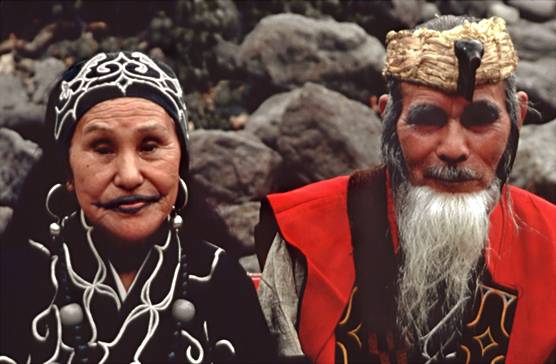
who: indigenes thought to be descendants of the jōmon-jin people.
where: japan and russia.
language(s): variations of ainu which, today, are spoken by fewer than one hundred people. the ainu languages have no written system, and they differ slightly from japanese in terms of syntax, vocabulary, morphology, etc.
culture: traditionally, the ainu did not shave after a certain age. both men and women had the same length of hair to the shoulders, and women tattooed their mouths and forearms. men primarily ate with chopsticks while women used wooden spoons.
dwellings: reed-thatched huts with central fireplaces and no partitions.
clothing: robes of varying lengths and other garments spun from the bark of elm trees. earrings were worn by both men and women, and in winter the people favored animal skins for warmth. for important ceremonies, men wore a wooden crown called a sapanpe, while women wore an embroidered headband called a matanpushi.
law: traditionally, capital punishment and jailing were not used to reprimand criminals. instead, violators of the law were beaten, or in the case of murder, were subject to having their noses and ears cut off and/or tendons in the feet severed.
diet: the ainu fished, hunted and gathered seasonal game and plants, which were then typically either cooked, smoked or dried for preservation and placed in storehouses. common proteins included bear, fox, salmon and deer.
religion: many are now practitioners of christianity, russian orthodoxism and buddhism, but animism is the traditional religion of the ainu people. animistic ceremonies frequently involved "sending back" the spirits of killed animals.
language(s): variations of ainu which, today, are spoken by fewer than one hundred people. the ainu languages have no written system, and they differ slightly from japanese in terms of syntax, vocabulary, morphology, etc.
culture: traditionally, the ainu did not shave after a certain age. both men and women had the same length of hair to the shoulders, and women tattooed their mouths and forearms. men primarily ate with chopsticks while women used wooden spoons.
dwellings: reed-thatched huts with central fireplaces and no partitions.
clothing: robes of varying lengths and other garments spun from the bark of elm trees. earrings were worn by both men and women, and in winter the people favored animal skins for warmth. for important ceremonies, men wore a wooden crown called a sapanpe, while women wore an embroidered headband called a matanpushi.
law: traditionally, capital punishment and jailing were not used to reprimand criminals. instead, violators of the law were beaten, or in the case of murder, were subject to having their noses and ears cut off and/or tendons in the feet severed.
diet: the ainu fished, hunted and gathered seasonal game and plants, which were then typically either cooked, smoked or dried for preservation and placed in storehouses. common proteins included bear, fox, salmon and deer.
religion: many are now practitioners of christianity, russian orthodoxism and buddhism, but animism is the traditional religion of the ainu people. animistic ceremonies frequently involved "sending back" the spirits of killed animals.
No comments:
Post a Comment